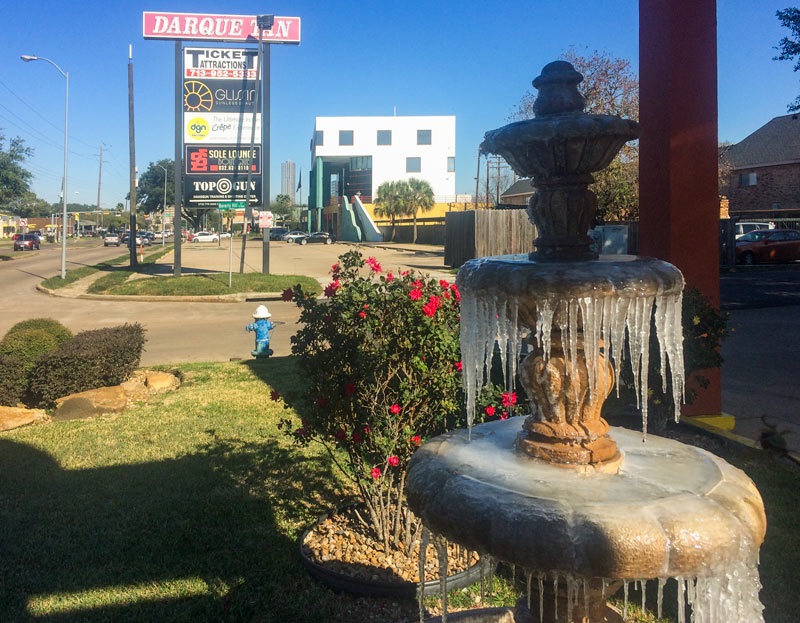
- About 3.4M SF of New Office Space Underway in Houston with 45% Preleased, According to PMRG [HBJ]
- Columbia Property Trust Sells All Houston Office Properties for $272M [Realty News Report]
- Co-Working Space Called Headquarters To Open in Converted EaDo Warehouse in February [Houston Chronicle]
- First Model Home Goes Up in Texas City’s Lago Mar Development [Houston Chronicle]
- Montrose Property Owners File Another Lawsuit Against Montrose Management District [Houston Chronicle; previously on Swamplot]
- Concerns About Fair Housing Mount as ‘Opportunity Index’ Tax Credit Guidelines Change [The Urban Edge]
- Long-Delayed Green Line Set To Open Wednesday with Free Rides Until Jan. 22 [Houston Chronicle]
- More Bricks Destroyed in Historic Freedmen’s Town [abc13; previously on Swamplot]
- Texas Had a Net Gain of 107,689 Residents in 2015, 4% Higher Than in 2014, Finds Texas Association of Realtors [HBJ]
- Hundreds of Stunned Turtles Recovering from Cold Weather Across Texas [Galveston County Daily News ($)]
Photo of Saturday’s freeze: Swamplot inbox
Headlines





Re Columbia Property Trust article: What do they mean by “high barrier market”?
The Metro Harrisburg train track overpass, while being an undesired, uninspired post-brutal span does offer a nice view of downtown followed by a glide-and-slide approach. All hail the Harrisburg Hump.
Re: Green Line Adds 2 More Stops
.
Nice that they are rolling out the ticker tape parade for the 2 new stops, which probably means that the ride is 5 minutes longer. Go for the gold: hurry up and build that thing to Hobby airport.
@ WBC: If any of the lines are ever extended to Hobby Airport (an unlikely prospect anytime soon), it should be the Purple (Southeast) Line, not the Green Line.
@ Wolf Brand Chili: It’d do the people living near Hobby Airport a much greater deal of good if state legislators would step in on their behalf and reform METRO and Harris County Transit so that these two agencies must work together and offer better services throughout southeast Harris County. Really very few of the folks that live over there work north of Griggs Road, but those that do work in that direction are already well-served. Many many more work in Pasadena or further southeast, and despite this being a fairly dense area, the level of service is just terrible. (It’s understandable as to why this is, by the way…but any fix will be legislative in scope.)
@ Local Planner: Ah, yes, you are right about that the Purple Line would be the logical one to go to Hobby. I studied Metro’s maps of the rail lines now and regret not seeing this sooner. My apology for the error.
.
They could take it straight down Mykawa Road then turn east near Airport Boulevard and take it right to Hobby. Make it an express for that section until they need to drop in a station if and when development occurs out there.
.
As The Niche said, it would be nice if the local jurisdictions (Harris County and METRO) could work closer together to cobble together a coherent and effective plan. But, I’ve been around for long enough to not hold my breath for that.
Reforming METRO through the legislative process is only unlikely at present because it’s difficult for Republican constituents in the suburbs and rural areas to see how doing so would benefit them, and so it doesn’t get prioritized. The issue is largely invisible to the bulk of them. Also, the transit agencies themselves are fiefdoms with long-standing political connections to local governments, congressional delegations, and labor unions and none of those have a compelling reason to upset that.
.
However, I would argue that there’s a new day dawning for public transit, that it’s worth Republicans looking at it, and that the State government needs to get out ahead of it and force agencies (which are chartered by the State government) to bridge the gap exclusively with legacy infrastructure and local buses, while forcing various agencies to consolidate regionally and to prepare for and focus on what’s coming.
.
In the same way as ridesharing has eviscerated taxi companies, autonomous jitney services will certainly wipe away the justification for many public transit services. Local and express buses, park-and-ride, light rail…it’s all going extinct. As jitneys become affordable and convenient, private automobile use should decline precipitously and traffic congestion issues and costly parking in the urban core are likely to fade as policy concerns.
.
The future of intra-regional public transportation infrastructure is going to be characterized by enhanced high-speed corridors. We won’t need to widen existing corridors very much, but we will want more of them with more and enhanced direct connections to the street grid in order to decentralize traffic patterns and prevent or minimize bottlenecks; HOV lanes may need to be converted to autonomous-only lanes and improved to support cruising speeds considerably higher than 100mph. Heavy rail may become more feasible, but only to the extent that it is very very fast, very frequent, and also competitive in terms of its cost; and that’s just about unthinkable without some new kind of technology (e.g. Hyperloop). For now though, it must be recognized that an empty ribbon of concrete is future-proof in nearly any reasonably foreseeable circumstance.
.
To that end, agencies need to identify corridors and begin setting aside easements. The legislature needs to start looking at methods for providing public financing for the new infrastructure. The legislature also needs to put in place very clear rules for overcoming grossly excessive NIMBYism, even when it arises from affluent neighborhoods; and it needs to do that now, before special interest groups are able to organize, mobilize, or unify over specific projects.